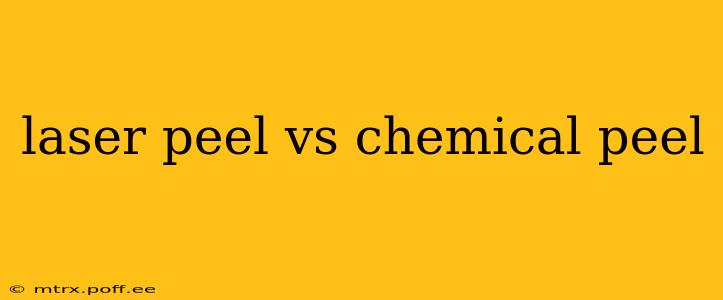Choosing between a laser peel and a chemical peel can feel overwhelming. Both procedures aim to rejuvenate the skin, improving texture, tone, and reducing the appearance of wrinkles and scars, but they achieve this through vastly different mechanisms. This comprehensive guide will delve into the key differences, helping you make an informed decision about which treatment best suits your individual needs and skin concerns.
What is a Laser Peel?
A laser peel, also known as laser resurfacing, uses a highly focused beam of laser light to remove the outer layers of skin. This controlled injury stimulates collagen and elastin production, leading to smoother, firmer skin. The depth of penetration varies depending on the type of laser used and the desired outcome. Different lasers offer varying degrees of invasiveness, ranging from ablative (removing skin layers) to non-ablative (heating the deeper skin layers without removing tissue).
Types of Laser Peels:
- Ablative Laser Peels: These offer more dramatic results but require a longer recovery period. They're typically used to treat significant wrinkles, acne scars, and sun damage.
- Non-Ablative Laser Peels: These are less aggressive, resulting in shorter downtime. They are often used for fine lines, uneven skin tone, and mild acne scarring.
What is a Chemical Peel?
A chemical peel uses a chemical solution to exfoliate the skin. The solution causes the top layers of skin to peel away, revealing smoother, fresher skin underneath. The depth of the peel depends on the type and concentration of the chemical solution used. Like laser peels, chemical peels come in varying strengths, catering to diverse skin concerns and sensitivities.
Types of Chemical Peels:
- Superficial Peels: These use mild acids like glycolic acid or salicylic acid and are ideal for treating mild acne, uneven skin tone, and fine lines. Recovery time is minimal.
- Medium Peels: These involve stronger acids like trichloroacetic acid (TCA) and target deeper wrinkles, sun damage, and acne scars. Downtime is moderate.
- Deep Peels: These are the most aggressive, using phenol to remove several layers of skin. They're typically reserved for severe wrinkles and scarring, with a longer recovery period.
Laser Peel vs. Chemical Peel: Key Differences
| Feature | Laser Peel | Chemical Peel |
|---|---|---|
| Mechanism | Laser energy removes or heats skin layers | Chemical solution exfoliates skin layers |
| Precision | Highly precise targeting of specific areas | Less precise, treats larger areas |
| Recovery Time | Varies greatly depending on the type of laser; can range from minimal to several weeks | Varies depending on depth; can range from minimal to several weeks |
| Cost | Generally more expensive | Generally less expensive |
| Suitable for | Wrinkles, acne scars, sun damage, uneven skin tone | Wrinkles, acne scars, sun damage, uneven skin tone, acne |
| Potential Side Effects | Swelling, redness, crusting, scarring (rare) | Swelling, redness, peeling, hyperpigmentation (rare) |
Which is Better for Me? What Should I Consider?
The "better" option depends entirely on your individual needs and preferences. Consider these factors:
- Severity of Skin Concerns: For deep wrinkles or severe scarring, a laser peel, particularly an ablative one, might be more effective. For milder concerns, a chemical peel might suffice.
- Downtime Tolerance: Laser peels, especially ablative ones, often require more significant downtime than chemical peels.
- Budget: Laser peels are typically more expensive than chemical peels.
- Skin Type and Tone: Your dermatologist will assess your skin type to determine the most appropriate treatment and minimize the risk of complications.
What are the risks and side effects of laser and chemical peels?
Both laser and chemical peels carry potential risks and side effects. These can include temporary redness, swelling, and peeling. In rare cases, more serious complications like scarring or infection can occur. It is crucial to choose a qualified and experienced dermatologist to minimize these risks.
How long does the recovery process take for a laser peel and a chemical peel?
Recovery time varies depending on the type of peel and the individual's skin. For superficial peels, recovery is often quick, with minimal downtime. Deeper peels, both laser and chemical, require longer recovery periods, potentially several weeks.
How much do laser and chemical peels cost?
The cost of laser and chemical peels can vary widely depending on the location, the type of peel, and the number of treatments needed. It's best to consult with a dermatologist for a personalized quote.
Are laser peels and chemical peels safe?
When performed by a qualified and experienced dermatologist, both laser and chemical peels are generally safe procedures. However, as with any medical procedure, there are potential risks and side effects. A thorough consultation is essential to assess your suitability and manage potential risks.
Choosing between a laser peel and a chemical peel is a personalized decision. Consulting with a board-certified dermatologist is crucial to determine the best treatment plan tailored to your unique skin concerns and goals. They can assess your skin, discuss your expectations, and recommend the most suitable and effective procedure. Remember, the ultimate goal is to achieve healthy, radiant skin while minimizing risks.
